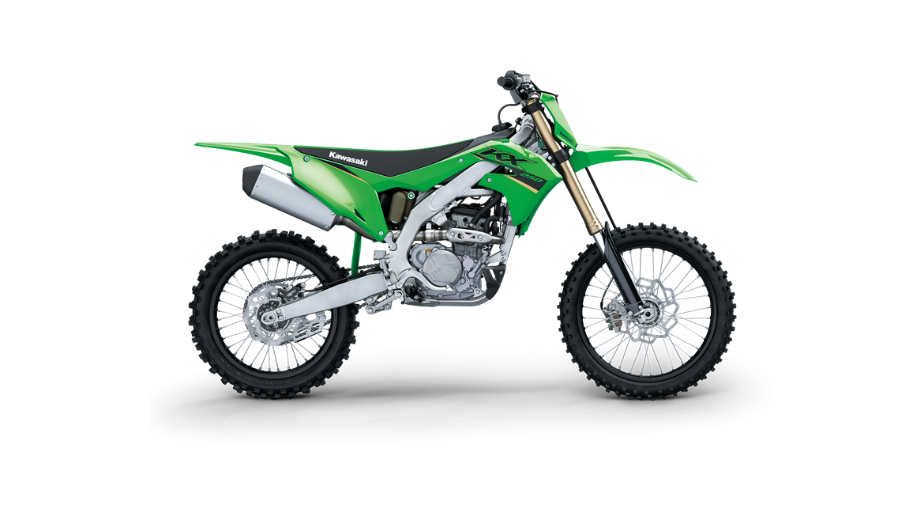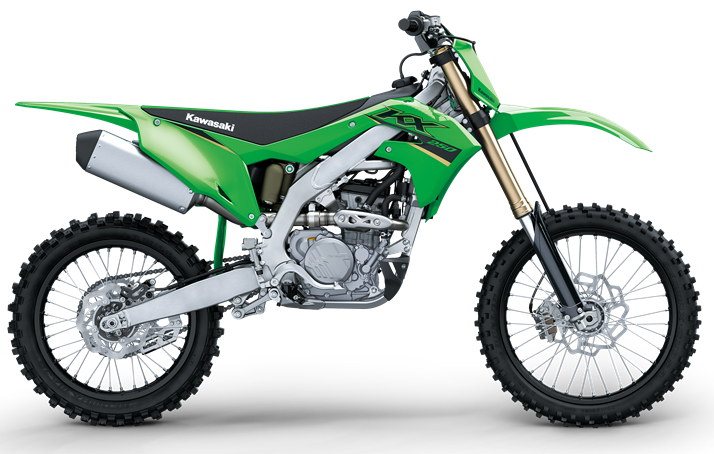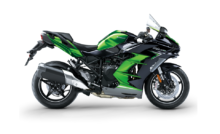2022 Kawasaki KX250 Clutch Owners Manual




2022 Kawasaki KX250 Clutch


Clutch
The motorcycle is equipped with a hydraulically operated clutch that requires no adjustment except fluid level inspection and clutch lever position.
Clutch Lever Position Adjustment
The clutch lever position can be adjusted to suit the rider’s preference.
- To adjust the clutch lever position, slide the clutch lever dust cover back, and loosen the locknut, and turn the adjuster to either side with a wrench.
- After adjustment, tighten the locknut securely.
A. Clutch Lever
B. Locknut
C. Adjuster
Start the engine and check that the clutch does not slip and that it release properly.
WARNING
Air in the clutch lines diminish clutch performance and can cause an accident resulting in injury or death. If the clutch lever feels mushy when it is applied, there might be air in the clutch lines or the clutch may be defec tive. Have the clutch checked immediately by an authorized Kawasaki dealer.
Clutch Fluid
Inspect the clutch fluid level in the clutch reservoir and change the clutch fluid in accordance with the Periodic Maintenance Chart. The clutch fluid should also be changed when contaminated with dirt or wa- ter. Use only heavy-duty clutch fluid as follows. Clutch Fluid DOT4
NOTICE
Do not spill clutch fluid onto any painted surface. Do not use fluid from a container that has been left open or that has been unsealed for a long time. Check for fluid leakage around the clutch system fittings. Check for clutch hose damage.
Clutch Fluid Level Inspection
With the clutch fluid reservoir positioned horizontally, the clutch fluid must always be the upper level. If the clutch fluid in the reservoir is low, check for fluid leaks in the clutch line and fill the reservoir to the upper level line.
A. Clutch Fluid Reservoir
B. Upper Level Line
WARNING
Mixing brands and types of hydraulic fluid can reduce the clutch system’s effective ness and cause an accident resulting in injury or death. Do not mix two brands of hydraulic fluid. Change the hydraulic fluid in the clutch line completely if the hydraulic fluid must be refilled but the type and brand of the hydraulic fluid that is already in the
reservoir are unidentified.
Friction and Steel Plates Removal
- Drain the engine oil (see Engine Oil section).
- Remove the brake pedal bolt and the rear brake pedal return spring.
A. Brake Pedal Bolt
B. Brake Pedal
C. Return Spring
Remove the clutch cover bolts.
A. Clutch Cover Bolts
B. Clutch Cover
- Remove the clutch cover and its gasket.
- Remove the clutch spring bolts.
- Loosen the clutch spring bolts evenly with little by little to prevent tilting the stopper plate.
NOTICE
Do not loosen the one or two clutch spring bolt at once to prevent stopper plate warpage by the spring force. Remove the holders, stopper plate, clutch spring and clutch pressure plate.
A. Clutch Spring Bolts
B. Holders
C. Stopper Plate
D. Clutch Spring
E. Clutch Pressure Plate
Remove the washer, needle bearing and push rod holder.
A. Washer
B. Needle Bearing
C. Push Rod Holder
D. Push Rod
NOTE
Do not remove the push rod. If the push rod is removed, clean the clutch slave cylinder and replace the O-rings of the clutch slave cylinder. Clutch slave cylinder disassembly should be serviced by referring to the Service Manual or an authorized Kawasaki dealer. Remove the friction plates, steel plates, and spring, and spring seats.
NOTE
- There are 3 different friction plates installed in the clutch plate assembly
- When servicing the clutch, use a permanent marker to identify each friction plate before re-moving them so that they can be reinstalled in the correct positions.
- Remove the clutch hub nut using the clutch holder (special tool: 57001-1900) to prevent the clutch hub from rotating.
- Remove the clutch hub.
A. Clutch Hub Nut
B. Clutch Holder (Special Tool: 57001-1900)
C. Spacer
D. Clutch Hub
Friction and Steel Plates Wear/Damage Inspection
- Visually inspect the friction and steel plates to see if they show any signs of seizure, or uneven wear.
- If any plates show signs of damage, replace all
friction plates and steel plates as a set. - Measure the thickness of the friction plates at several points with vernier calipers.
- If they have worn past the service limit, replace them with new ones.
Friction Plate Thickness Measurement
A. Thickness
B. Friction Plate
B. Friction Plate (identification Paint Color: Blue)
C. Friction Plates (identification Paint Color: Light Blue)
D. Friction Plate (identification Paint Color: Pink)
E. Steel Plates
F. Clutch Pressure Plate
G. Clutch Spring
H. Stopper Plate
I. Holders
J. Clutch Spring Bolts
K. Standard Length
L. Spring
M. Spring Seat
- If they have worn past the service limit, replace all friction plates with new ones.
- If the friction plates are replaced, measure the clutch plate assembly length, and use the steel plates in the following table so that the clutch plate assembly length is standard.
NOTE
Do not use the steel plate of 1.6 mm (0.062 in.) and 1.2 mm (0.047 in.) thickness at the same time.
Friction and Steel Plate Warp Inspection
- Place each friction plate and steel plate on a surface plate, and measure the amount of friction plate and steel plate warp with a thickness gauge (ie., the gap between the surface plate and each friction plate or steel plate).
- If any plate is warped over the service limit, replace it with a new one.
Friction and Steel Plate Warp
A. Surface Plate
B. Friction or Steel Plate
C. Thickness Gauge
Clutch Hub Installation
- Install all parts in the reverse order of removal.
- Install the clutch hub.
- Install the spacer.
- Replace the clutch hub nut with a new one.
- Apply molybdenum disulfide oil solution to the con- tact area of the clutch hub nut.
- Tighten the clutch hub nut with using the clutch holder (special tool: 57001-1900) to the specified torque.
A. Clutch Hub
B. Spacer
C. Clutch Hub Nut
D. Clutch Holder (Special Tool: 57001-1900)
Tightening Torque
Clutch Hub Nut: 100 Nm (10.2 kgfm, 73.8 ft-lb)
Friction and Steel Plate Installation
- Install all parts in the reverse order of removal.
- Install the spring seat and spring as shown.
- Install the friction plates and steel plates, alternating between the two; be sure to start and finish with a friction plate.
A. Spring Seat
B. Spring
C. Friction Plate (ldentification Paint Color: Pink)
D. Friction Plates (ldentification Paint Color: Light Blue)
E. Friction Plate (ldentification Paint Color: Blue)
F. Steel Plates
NOTICE
If dry steel plates and friction plates are installed, apply engine oil to the surfaces of each plate to avoid clutch plate seizure.
- Apply molybdenum disulfide grease to the contact area of the push rod and push rod holder, both surface of the needle bearing and washer.
- Install the push rod holder, needle bearing and washer.
Apply molybdenum disulfide grease to the contact area of the push rod and push rod holder, both surface of the needle bearing and washer. Install the push rod holder, needle bearing and washer.
A. Apply molybdenum disulfide grease.
B. Push rod
C. Push Rod Holder
D. Needle Bearing
E. Washer
- If the holders are damaged, replace it.
- Install the clutch pressure plate, clutch spring, stopper plate and holders.
- Tighten the clutch spring bolts evenly with little by little to prevent tilting the stopper plate.
NOTICE
Do not tighten the one or two clutch spring bolt at once to prevent stopper plate warp age by the spring force. Tighten the clutch spring bolts to the specified torque.
Tightening Torque
Clutch Spring Bolts: 9.0 Nm (0.92 kgfm, 80 in-Ib)
- Replace the clutch cover gasket with a new one.
- Install the clutch cover to the right engine cover and tighten its bolts to the specified torque.
Tightening Torque
Clutch Cover Bolts: 10 Nm (1.0 kgf m, 89 in-b)
- Install the return spring.
- Replace the O-rings on the brake pedal bolt with new ones and install them.
- When installing the brake pedal, apply the grease to the contact area of the brake pedal pivot and ap- ply a non-permanent locking agent to the threads of the brake pedal bolt.
Tightening Torque
Brake Pedal Bolt: 25 Nm (2.5 kgfm, 18 ft-lb) Pour the engine oil (see Engine Oil section).
Recent Posts
VW Jetta Engine Fuse Box Diagram
Access the comprehensive 2010-2018 VW Jetta Passenger Fuse Box Diagram to troubleshoot electrical issues effectively.…
VW Jetta Passenger Fuse Box Diagram
Explore the comprehensive VW Jetta Passenger Fuse Box Diagram to troubleshoot electrical issues effectively. Understand…
2023 Ford F-150 Lightning Fuse Box Diagram
Under Hood Fuse Box Location Remove the front luggage compartment cover. Under Hood Fuse Box…
2022 Kawasaki NINJA H2 SX SE Brake Lever Adjuster Owner’s Manual
2022 Kawasaki NINJA H2 SX SE Brake Lever Adjuster Owner's Manual NOTICE Only adjust the front…
2023 Land Rover Range Rover Evoque Exiting The Vehicle Owners Manual
2023 Land Rover Range Rover Evoque Exiting The Vehicle SINGLE LOCKING WARNING Before exiting the…
2023 Land Rover Range Rover Evoque Front Seats Owners Manual
2023 Land Rover Range Rover Evoque Front Seats FRONT SEAT SAFETY Make sure to read…
